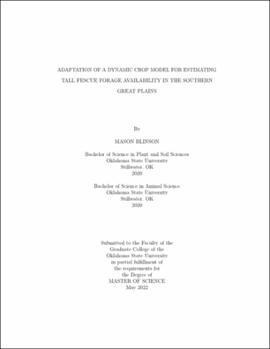| dc.description.abstract | Due to interannual and cross-location variability of forage production, ranchers oftenencounter difficulties anticipating which management strategies should be used for optimum pastureland management. While models for predicting forage production are available to aid management decisions for some forage crops, there is limited research for a yield model designed specifically for tall fescue (Festuca arundinacea Schreb.). Therefore, our objective was to adapt an existing DSSAT-CSM-Perennial forage model for predicting forage biomass of tall fescue in the southern Great Plains. To evaluate model performance, there must first be a high level of data manipulation and cleaning. In this thesis, a cohesive dataset combining biomass, weather, soil, and management data is structured into DSSAT standard file format to be used in future tall fescue crop modeling analysis. Model inputs are obtained from multiple sources, weather data from the Oklahoma Mesonet and the University of Georgia Weather Network and soil data from SSURGO. The model performance was inconsistent in predicting seasonal differences in biomass production. The model is under-predicting harvestable biomass for the agronomic site, Ardmore (AGR), with a mean bias of -376 kg ha−1, and it is over-predicting for the breeder sites with a mean bias of 664 kg ha−1. The model was not able to adequately predict harvestable biomass of tall fescue for either the breeder data [Willmott agreement index (D) of 0.61, a Nash-Sutcliffe model efficiency (ME) of -1.06, root mean squared error (RMSE) of 2408] or the agronomic data (D = 0.63, ME = 0.02, and RMSE = 5124). For the model to provide more accurate predictions of harvestable biomass, further parameterization will be required through calibration of parameters that control above- to below-ground partitioning, response to temperature, and maximum leaf photosynthesis rate. Calibration will require identifying and adapting parameters that negatively affect production which will increase the model’s ability to predict forage biomass. | |
